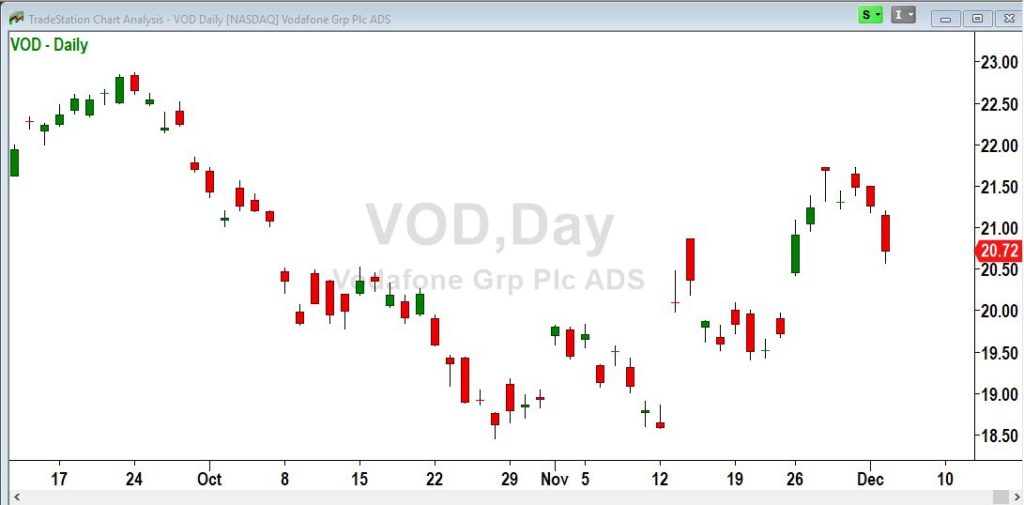This strategy works best when a stock has recently had a sharp drop, to a point that you believe is a bargain price. It will allow you to buy the stock at a discount from the current market, if the stock behaves as you expect. And if the stock suddenly soars, you may make a tidy profit even though you missed buying the stock. Here’s how it works.
When stocks drop sharply, some of the people who hold them buy put options as protection. From their point of view, they are buying a guaranteed stop-loss. This increased demand for puts drives up their price.
A savvy investor can then sell put options on the stock in such a way that the only possible outcomes are
- Purchase of the stock at a significant discount to the present market price or
- A high return on the cash that is committed to the potential stock purchase.
Example Put Option Trade
*Example only, not a trade recommendation*
Early in December, the stock of Vodafone (VOD) seemed to be reversing its months-long slide. The Financial press were reporting that new management had frozen the dividend at current levels in order to reduce debt, with plans to resume increasing it when this was accomplished. The market had responded positively.
Even though frozen currently, the dividend yield was still quite attractive at well over 8%. The stock had broken out of a long-term downward channel as shown here:

In the first week of December a sell-off gripped the markets and VOD was knocked down by about 5%, in line with the indexes, as shown here:

If you believed that VOD, with its good dividend yield and substantial positive free cash flow, was a good long-term investment, then here was an opportunity to buy it at an attractive price.
With the stock at $20.72, 500 shares would cost just a little over $10,000 ($10,360 to be exact).
At this time, put options expiring on January 18 (43 days away at the time) at the $21.00 strike price could be sold for about $.93 per share. Instead of buying the stock at its current price, the investor could have used the cash to secure the sale of five of these puts, collecting 5 X $93.00 = $465 in immediate cash. This put sale would obligate the investor to buy the shares if and when exercised, for $21.00 per share, a total of $10,500. Subtracting the $465 already collected as premium on the puts, the total cost of the 500 shares would be $10,035, or $20.07 per share. This would be a saving of $.65 per share or about a 3.1% discount compared to the current price of $20.72.
And that would be the outcome if VOD remained below $21.00 for the next 43 days.
What if it didn’t?
If VOD were to be above $21.00 at the January 18 expiration date, then the puts would not be assigned – they would simply expire, worthless. The investor would not receive the stock. He would, however, retain the $465 in cash originally received for the puts. On his cash tied up of $10,500 ($2100 per put times five), that $465 represents a payoff in 43 days of 4.4%, for an annualized return of over 37.5%!
So, given that the VOD stock represented an asset that the investor would like to own, the put sale strategy would result in either acquiring the stock at over a 3% discount; or making an annualized return of over 37.5%.
So what could go wrong? The worst case would be that the VOD stock would continue to drop in price, so that it was worth less than its $20.07 cost. In that case, the investor would plan to hold the stock, drying his tears with the 8% dividend checks.
Russ Allen can be contacted on this link: Russ Allen
Last edited by a moderator:
